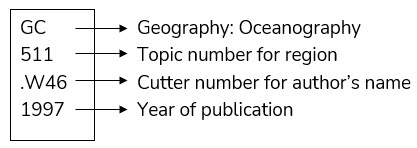- Print
- DarkLight
- PDF
Another prominent classification system used in the states is Library of Congress Classification, which is also referred to as LCC or LC. As the name suggests, LCC was developed by the Library of Congress and was created with the intention of providing more extensive categories. For that reason, it is primarily used in larger libraries, such as academic and research institutions.
Structure
The structure of a LCC number goes line by line, with most call numbers having at least four lines. Starting with the major class (subject) and narrowing as the viewer goes down. There are 21 major classes, which are represented by the first letter on the top line. Typically, a second letter (and maybe a third) is present, which is reflective of a subclass.
The second line is the topic line, or division line, which further subdivides the topic. This line is typically represented by numbers, and it can represent several components of the subclass, such as form, place, and/or time.
The third line most often provides the cutter number, which is displayed as a decimal followed by the first letter of the author’s last name and numbers that correlate to the remainder of the letters in that name.
The last line is the year of publication.
Example
Book title: Marine Environmental Assessment of the Estuary and Gulf of St. Lawrence
Author: Louise White
Published: 1997
Call number: GC 511 .W46 1997

Additional lines may be appropriate, depending on the resource in hand and the specificity of the topic. As you’ve probably recognized, the LCC system is quite complex! For this reason, many catalogers rely on checking call numbers through the Library of Congress Catalog instead of creating them from scratch.


